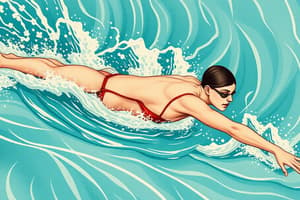Podcast
Questions and Answers
Ear plugs help maintain visibility underwater.
Ear plugs help maintain visibility underwater.
False (B)
Swim caps mainly reduce drag to enhance speed through the water.
Swim caps mainly reduce drag to enhance speed through the water.
True (A)
Nose clips prevent water from entering the ears while swimming.
Nose clips prevent water from entering the ears while swimming.
False (B)
Goggles with prescription lenses are available for swimmers who wear glasses.
Goggles with prescription lenses are available for swimmers who wear glasses.
Swim caps protect hair from chemical damage caused by chlorine.
Swim caps protect hair from chemical damage caused by chlorine.
Earplugs are used to prevent water from entering the ears while swimming
Earplugs are used to prevent water from entering the ears while swimming
A swimsuit's primary function is to provide warmth during swimming
A swimsuit's primary function is to provide warmth during swimming
Goggles are considered essential swimming equipment
Goggles are considered essential swimming equipment
A nose clip is used to prevent water from entering the nose while swimming
A nose clip is used to prevent water from entering the nose while swimming
Swim caps are only worn for competitive swimming events
Swim caps are only worn for competitive swimming events
Flashcards are hidden until you start studying
Study Notes
Swimming Equipment: Essentials for Effective Aquatic Training and Performance
Swimming is a popular form of exercise and competitive sport that requires various tools to enhance performance, train effectively, and protect against environmental factors. Here's a comprehensive breakdown of the essential swimming equipment for lap swimming and open-water swimming, covering earplugs, swimsuits, goggles, nose clips, swim caps, pull buoys, swimming noodles, kickboards, hand paddles, and swim watches.
Earplugs: Preventing Discomfort and Infections
Some swimmers opt for earplugs to prevent water from entering their ears while swimming. Water in the ear canal can cause discomfort and increase the risk of developing swimmer's ear, an outer ear infection caused by bacteria often found in pools. Earplugs create a seal, keeping water out and reducing the chance of irritation or infection.
Swimsuit: Comfortable and Functional Attire
A well-fitting swimsuit is crucial for comfort, support, and proper movement during laps or open-water swimming. High-quality swimsuits provide flexibility, freedom, and protection against chlorine damage. Oftentimes, specialized suits are available for different purposes, such as training equipment like snorkeling masks and fins for open-water swimming.
Goggles: Clear Vision Underwater
Goggles protect eyes from chlorinated water and help maintain visibility underwater. They come in various styles, including those with prescription lenses for swimmers who wear glasses. Goggles are essential for lap swimming and open-water swimming alike, ensuring you can see your surroundings without being affected by chemicals in pools.
Nose Clip: Keeping Nostrils Dry
Similar to earplugs, nose clips prevent water from entering the nasal cavity while swimming. This helps reduce discomfort and the likelihood of sinus issues or respiratory problems arising from prolonged exposure to wet conditions.
Swim Cap: Reducing Drag and Protecting Hair
The swim cap plays multiple roles during aquatic activities. Professionally, it reduces drag to enhance speed through the water. Additionally, swim caps keep hair away from the face and help shield hair from chlorine damage, making it easier to manage. For open-water swims, these benefits become even more valuable due to potential sun exposure and environmental factors.
Pull Buoy: Enhancing Arm Technique
Pull buoys are foam flotation devices that attach between the legs, allowing swimmers to focus on arm technique rather than relying on leg strength for propulsion. By isolating lower body movements, this piece of equipment promotes better form and targeted upper body development.
Swimming Noodle: Improving Buoyancy and Stability
Swimming noodles are long, flexible floats designed to assist swimmers in maintaining buoyancy and stability while practicing kicks and other exercises. These tools enable individuals to build confidence in the water and improve overall swimming skills.
Kickboard: Targeting Lower Body Strength
Kickboards are essential for lap swimming to isolate leg movements and develop proper kicking technique while strengthening the lower body muscles involved in swimming. By focusing on specific aspects of training, swimmers can make significant progress in both performance and fitness.
Swim Watch: Tracking Performance Metrics
Swim watches provide real-time data and analytics to help track workouts, monitor heart rate, and assess overall swimming performance. These devices allow users to analyze their progress, adjust training routines accordingly, and gain insights into their aquatic abilities.
Hand Paddles: Increasing Upper Body Strength
Hand paddles add resistance to arm movements during swimming exercises, promoting upper body strength development. This equipment assists swimmers in improving stroke mechanics and enhancing overall performance through targeted training sessions.
In conclusion, understanding the purpose and functionality of various swimming equipment pieces enables swimmers to optimize their workouts and enhance their skills both in competitive events and recreational settings. Whether focusing on lap swimming or open-water adventures, the appropriate gear ensures a more effective, enjoyable, and safe aquatic experience.
Studying That Suits You
Use AI to generate personalized quizzes and flashcards to suit your learning preferences.




